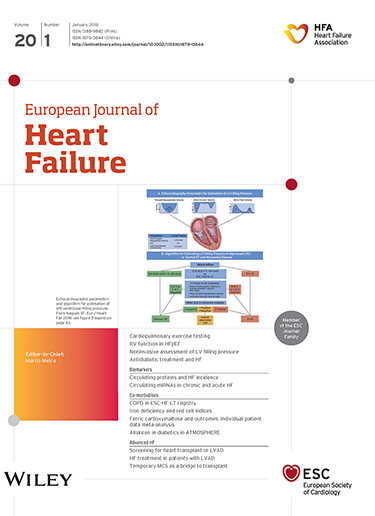血压,安全性和临床疗效vericiguat慢性心力衰竭伴射血分数降低:来自VICTOR试验的见解。
IF 10.8
1区 医学
Q1 CARDIAC & CARDIOVASCULAR SYSTEMS
引用次数: 0
摘要
目的:VICTOR试验研究了vericiguat对慢性心力衰竭伴射血分数降低(HFrEF)患者在当代心力衰竭(HF)治疗中且近期无恶化的有效性和安全性,但一些亚组可能更容易出现症状性低血压。方法和结果在接受至少一剂研究药物或安慰剂的VICTOR试验参与者中,我们描述了收缩压(SBP)随时间的轨迹(从基线的平均变化),症状性低血压事件和vericiguat在潜在易感患者亚组中的疗效:较低的基线血压(收缩压≤110 mmHg),年龄较大的患者(bb0 ~ 75岁)和基线时服用血管紧张素受体-萘利溶素抑制剂(ARNI)或钠-葡萄糖共转运蛋白2抑制剂(SGLT2i)的患者。使用Cox比例风险模型检查基线收缩压期间心血管死亡和心衰住院以及单独心血管死亡的疗效结局。总体收缩压轨迹显示,与安慰剂相比,vericiguat治疗患者的初始收缩压较基线有小幅下降(安慰剂校正差异为-1.17 [-1.84,-0.50],p = 0.0007),且在整个随访过程中相对稳定。这一轨迹在bbb75岁(与年轻人相比)、接受ARNI或SGLT2i(与未接受ARNI或SGLT2i的患者相比)或基线收缩压≤110 mmHg(与>110 mmHg相比)的患者中相似。11.3%的vericigut组患者出现症状性低血压,而安慰剂组患者出现症状性低血压的比例为9.2%,校正风险比为1.24(95%可信区间1.06-1.46),在年龄、SBP、SGLT2i和ARNI组中相似(所有相互作用p < 0.05)。与安慰剂相比,vericiguat的治疗效果在基线收缩压范围内相似(两者相互作用p >0.15)。结论:与安慰剂相比,vericiguat显示收缩压的轻微调整降低,导致更多的症状性低血压,但在广泛的HFrEF人群中,即使在那些易感低血压的人群中,在当代治疗中总体耐受性良好。无论基线收缩压如何,治疗效果对疗效结局的影响是一致的。本文章由计算机程序翻译,如有差异,请以英文原文为准。
Blood pressure, safety and clinical efficacy of vericiguat in chronic heart failure with reduced ejection fraction: Insights from the VICTOR trial.
AIMS
The efficacy and safety of vericiguat in patients with chronic heart failure with reduced ejection fraction (HFrEF) on contemporary heart failure (HF) therapies and without recent worsening was investigated in the VICTOR trial, yet some subgroups may be more susceptible to symptomatic hypotension.
METHODS AND RESULTS
Among VICTOR trial participants that received at least one dose of study drug or placebo, we describe the systolic blood pressure (SBP) trajectories over time (mean change from baseline), symptomatic hypotension events and efficacy of vericiguat in potentially vulnerable patient subgroups: lower baseline blood pressure (SBP ≤110 mmHg), older patients (>75 years) and those taking angiotensin receptor-neprilysin inhibitors (ARNI) or sodium-glucose co-transporter 2 inhibitors (SGLT2i) at baseline. The efficacy outcomes of cardiovascular death and HF hospitalization and cardiovascular death alone across baseline SBP were examined using Cox proportional hazards models. Overall SBP trajectories showed a small initial decline from baseline in vericiguat-treated patients compared with placebo (placebo-corrected differences of -1.17 [-1.84, -0.50], p = 0.0007) that was relatively stable throughout follow-up. This trajectory was similar in those >75 years (vs. younger) as well as those receiving ARNI or SGLT2i (as compared with those not receiving these) or those with SBP ≤110 mmHg at baseline (compared with >110 mmHg). Symptomatic hypotension occurred in 11.3% of vericiguat-treated patients compared with 9.2% of placebo-treated patients with an adjusted hazard ratio of 1.24 (95% confidence interval 1.06-1.46), which was similar across age, SBP, SGLT2i and ARNI groups (all interaction p >0.05). The treatment effect of vericiguat compared with placebo on the efficacy outcomes was similar across the spectrum of baseline SBP (both interaction p >0.15).
CONCLUSIONS
Vericiguat showed a slight adjusted decrease in SBP and resulted in more symptomatic hypotension compared with placebo but was overall well-tolerated in a broad population with HFrEF on contemporary therapy even among those predisposed to hypotension. Treatment effects on efficacy outcomes were consistent regardless of baseline SBP.
求助全文
通过发布文献求助,成功后即可免费获取论文全文。
去求助
来源期刊

European Journal of Heart Failure
医学-心血管系统
CiteScore
27.30
自引率
11.50%
发文量
365
审稿时长
1 months
期刊介绍:
European Journal of Heart Failure is an international journal dedicated to advancing knowledge in the field of heart failure management. The journal publishes reviews and editorials aimed at improving understanding, prevention, investigation, and treatment of heart failure. It covers various disciplines such as molecular and cellular biology, pathology, physiology, electrophysiology, pharmacology, clinical sciences, social sciences, and population sciences. The journal welcomes submissions of manuscripts on basic, clinical, and population sciences, as well as original contributions on nursing, care of the elderly, primary care, health economics, and other related specialist fields. It is published monthly and has a readership that includes cardiologists, emergency room physicians, intensivists, internists, general physicians, cardiac nurses, diabetologists, epidemiologists, basic scientists focusing on cardiovascular research, and those working in rehabilitation. The journal is abstracted and indexed in various databases such as Academic Search, Embase, MEDLINE/PubMed, and Science Citation Index.
 求助内容:
求助内容: 应助结果提醒方式:
应助结果提醒方式:


